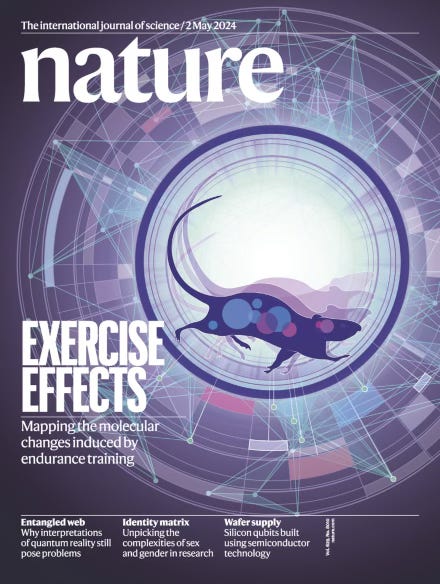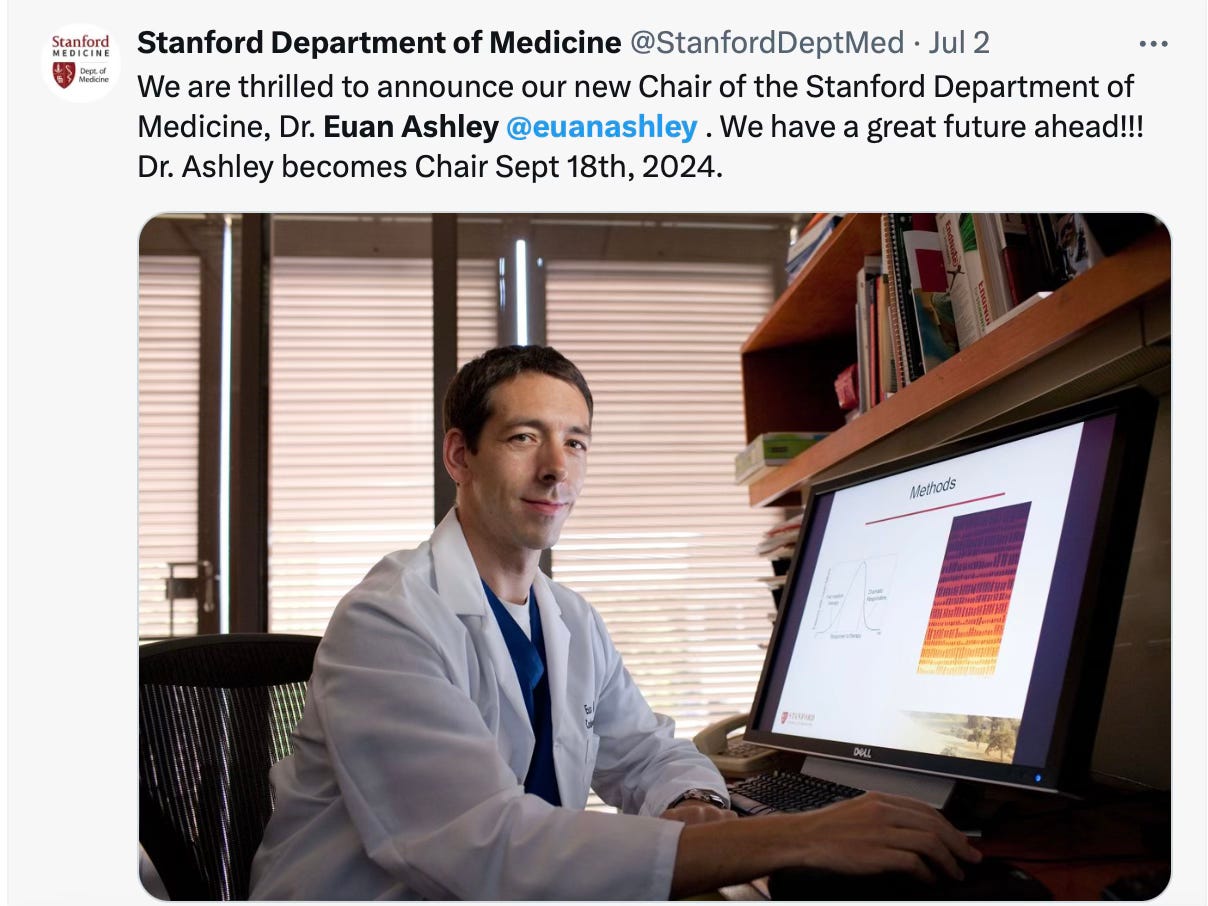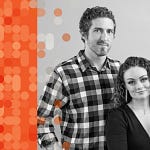Recently, a series of papers were published in Nature and Nature journals illuminating the physiologic effects of exercise from an NIH initiative called MoTrPAC. To understand the wealth of new findings, I spoke with Professor Euan Ashley, who, along with Matt Wheeler, heads up the bioinformatics center.
Earlier this week, Stanford announced Euan Ashley will be the new Chair of the Department of Medicine. He has done groundbreaking work in human genomics, including rapid whole genome sequencing for critically ill patients and applying the technology for people with unknown diseases. A few years ago he published The Genome Odyssey book. As you’ll see from our conversation, he has also done extensive work on the science of exercise.
Video snippet from our conversation. Full videos of all Ground Truths podcasts can be seen on YouTube here. The audios are also available on Apple and Spotify.
Transcript with audio and external links
Eric Topol (00:06):
Well, hello, it's Eric Topol with Ground Truths, and I'm really delighted today to welcome my friend, Euan Ashley. He is the Roger and Joelle Burnell Chair of Genomics and Precision Health at Stanford. He's done pioneering work in genomics, but today we're going to talk about something very different, which he also is working in exercise. Exercise the cover of a Nature paper in May regarding this MoTrPAC, which we're going to talk about this big initiative to understand the benefits of exercise. But before I hand it over to Euan, and I just want to mention his description of the paper that he posted to summarize started with, “Exercise may be the single most potent medical intervention ever known.” So Euan welcome.
Euan Ashley (01:01):
Yeah, well, great. It's wonderful to be here, Eric, and so nice to see you.
Eric Topol (01:06):
Yeah. Well, we have a lot to talk about because exercise is a fascinating topic. And I guess maybe we'd start with the MoTrPAC, which is an interesting acronym that you all came up with. Maybe tell us a bit about that with the 800 rats and the 2,400 people and the 17,000 molecules, there’s a lot there.
Euan Ashley (01:24):
Right, right. Yeah. Well, first of all, of course, before you do any scientific study, especially with a large number of people in a consortium, you need a good acronym. So that was where we started with the idea was to focus on the molecular transducers of physical activity. As you pointed out there at the beginning, we really don’t have a more potent medical intervention, especially for prevention of disease. I mean, it’s just such a powerful thing that we have, and yet we don’t really understand how it works. And so, the MoTrPAC Consortium was designed to really work together, bring groups of people across the US together who all have some interest in exercise and some ability to measure molecules and really put together the world's largest study of exercise to try and start answering some of the questions about where the potency of this intervention come from.
Eric Topol (02:20):
So the first crop of papers, and there were several of them that came out all on the same day in Nature publications, was about the rats. The people part is incubating, but can you give us a skinny on, there was a lot there, but maybe you could just summarize what you thought were the main findings.
Key MoTrPAC Findings
Euan Ashley (02:43):
Yeah, of course, of course. And the MoTrPAC Consortium, I'll say first of all, yeah, large group is probably I think 36 principal investigators funded by the Common Fund. And so, it brings together large numbers of people, some of whom who spend most of their time thinking about let’s say animal exercise. Some have spent a lot of time thinking about humans in exercise and many of whom think about measuring technologies. And as you say, these first group of papers were focused on the rat study, but actually the study goes much more broadly than that. But of course, there are some advantages to the animal protocols. We can look at tissue and we'll talk about that in a moment. But the humans, of course, are where we're most interested in the end. And we do have tissues coming from humans blood and adipose tissue and skeletal muscle, but those are obviously the only organs we can really access.
(03:31):
So there's a rat study, which is this one we'll talk about, and that's aerobic exercise and training. There's human studies that include aerobic exercise, strengths studies as well. There's a study in kids, pediatric study and then also a study of people who are very fit because here we're focusing on the change from sedentary to fit. And so that gives us the key exercise signal. So this first crop of papers was really our first look, cross-tissue, cross multi-omics, so multiple different modalities of measurement. And I think, yeah, we were like about nine and a half thousand assays, 19 tissues, 25 different measurement platforms, and then four training points for these rats. So let's talk about the rats for a minute. What do they do? So they normally live at night. They're active at night. In this study, we reverse that so that we can actually do the studies during the day.
(04:25):
So we reverse their at night cycle and they do their treadmill exercise over the course of several weeks. They start with about 20 minutes, and they do more every day. There's a control group of rats that just get placed on the treadmill and then don't do any exercise. And so, this is a controlled study as well. And over the course of time, we work more, it's about eight weeks in total and then two days after each of those bouts of exercise. So it's not an acute study, we measure to see where we are. So we also have this time trajectory of exercise. So what did we find? I mean, I think the first thing I would say, we talked about just how potent exercise is. It's very, very clear from looking at all these tissues that when you exercise regularly, you are just a different person, or in this case a different rat.
(05:15):
Like literally every tissue is changed dramatically and some in quite surprising ways. So I give you a couple of the things that surprised me or that I thought were most interesting. The first thing was this question of how does exercise actually work? Because exercise is a stress. You go out and you pound the pavement or you're on the bike or whatever, and then your body recovers. And so, there's been this idea, it's referred to as hormesis, this idea that some of the benefit of exercise might come from this recurrent stress. So your body learns how to deal with stress. And so given that we were very interested that this heat shock response was so prominent across multiple tissues. So heat shock proteins are molecular chaperones and they take care of protein folding to make sure it's appropriately done and they prevent protein aggregation. And when proteins need degraded because they're damaged, the heat shock system jumps in.
(06:10):
So perhaps not surprising, but pretty interesting that the heat shock proteins were very prominent part of the stress response to exercise. And remember, this is not acute exercise, so these are benefits that are built up over time, so that was one. A surprising one to me, the adrenal gland. So we're used to thinking of adrenaline as an epinephrine, as a stress hormone, but actually we saw dramatic changes in the adrenal gland and we don't necessarily think too much. You think about the exercising muscles, you think about the heart, we think about the lungs, when we think about exercise, you don't necessarily think that you're changing your adrenal gland, but it was one of the most changed tissues. The immune system was a common upregulated system. We saw that. And in fact, some of the tissues in which the immune genes were most changed were somewhat surprising.
(07:02):
So the small intestine, for example, was a place where there was a highest enrichment of immune mediated pathways. And then some tissues changed pretty early, like the small intestine changed after just one or two weeks of training other tissues like the brown adipose tissue. It was more like seven or eight weeks of training before we saw the real changes in there. So just one or two little things that struck out, but I think this really the first molecular map of exercise. So we're looking across the whole system across multiple modalities of measurement across multiple tissues.
Simulating Stress
Eric Topol (07:34):
So as far as understanding the benefits of exercise, does this tell us that it really does simulate stress that it's conditioning the body to deal with stress as reflected by the various points you just summarized?
Euan Ashley (07:51):
Yeah, I think that is exactly right. I mean, part of what we were trying to understand was in what way are you changed after you do exercise regularly? And I think if we think about things that are positive, then the ability to deal with stress at a cellular level, quite literally repair mechanisms seems to be a big part of it. The other aspect that was interesting is that when you're measuring this many analytes, you can also compare that with disease. And so, we understand that exercises is preventive benefit against disease. So in some cases, and this was work highlighted by my colleague Maléne Lindholm in the mitochondrial paper that came along with the main paper and she looked with a team across all mitochondrial changes across all of the tissues of the cell. So these are the workhorses of the individual cells that like the batteries inside the cells of the mitochondria.
(08:54):
And we saw big changes across, it's not surprisingly, but it's the energy source for cells, big changes across many tissues. But interestingly for two specific really important diseases, a liver disease in one case and type 2 diabetes on the other, it was very clear that the training upregulated a network that was exactly the opposite of that of the disease. And so, it really was intervening in a way that was very specifically opposite to the way we know disease mechanisms go. So it does seem like, I mean people talk about an exercise pill. I think this shows that that is just not going to be possible. There may be ways we could mimic some elements of exercise, but there's no pill. This is a multisystem, multi-tissue, multidimensional response to exercise.
Eric Topol (09:44):
Yeah, I think it's really important. That was one of the questions I was going to ask you is whether this would ever be simulated by a drug. And I think you already answered that, and the fact that it's so comprehensively sweeping across every organ and all these different signals, tens thousand plus signals across them, it's really striking. We never really understood the benefits of exercise and not that it's all resolved by any means. Some of the things that were interesting too was the sex specific findings. Maybe you want to comment about that because we don't spend enough time thinking about how sex does have a big effect on physiology.
Sex-Specific Findings
Euan Ashley (10:24):
Yeah, I mean that's a really good point and one that I think was really underlined for us at every corner, every turn of the analysis here. So really no matter which measurement modality, no matter which tissue, no matter which point of training, if we just asked these computer models to sort of separate the data according to the prominent signals without giving it a clue of what to do, the so-called unsupervised models, then sex basically came out every single time. So I think you say you're absolutely right that we so often overlook the difference. For years we've said, oh, it's too expensive to do animal studies in both sexes, so we'll just pick one. And males were picked more often. But there are plenty of studies that were just females, and I mean that clearly is wrong, and we are really, sometimes it appeared like we're almost dealing with two different species.
(11:18):
They were so different. But I think we can also learn from what those differences were. Interestingly, some of them were most profound in adipose tissue, so in fat, and that was the case both at rest, sedentary and amplified by exercise. So we saw big difference between females and males in relation to the kinds of signals that were prominent in the white adipose tissue. So this fat storage tissue, for example, in sedentary females, insulin signaling and the trigger to make fat and store fat was very prominent. But whereas in the males, even before any exercise, the fat signals were more related to metabolism, and we could have wild speculation about in evolutionary terms why that might be. Obviously, males and females have different biological many differences in their biology and obviously thinking about hormone systems and specifically pregnancy of course. And so, we could probably come up with some theories. In reality, all we know now are these observations were found and they're pretty interesting and they show us that we really always need to think separately about both sexes and look at both independently.
Eric Topol (12:39):
Well, and the other thing that you already pointed out, but I just want to underscore, you can't do this stuff in people. You can't just do fat biopsies and whatnot. So I mean, the fact that you can do this multi-omic, multi-organ type assessment is just really an extraordinary opportunity for learning. And while we're on the white fat story just briefly, we would rather have a lot more brown fat, but as we age, and I assume it's the same in rats, they don't have much as they get older brown fat. Does exercise help us get more brown fat or are we just stuck with the white adipose tissue?
Brown vs White Fat
Euan Ashley (13:21):
Yeah, well, it certainly allows us to have less of a white adipose tissue, and I think it's potential that our brown adipose tissue maybe more functional, and for those who are listening who are not familiar, I mean these really are different colors that relate to the actual color of the tissue, but the color is different because the brown adipose tissue contains lots of mitochondria and lipid droplets, and the brown adipose is there to help essentially generate heat. It has a very different function in a way, but even white adipose tissue that we think of as just being about storing energy, people think of fat as a very metabolically neutral or inert tissue, but in reality it's not. It's signaling. It's constantly, it's a tissue that's as alive as any other and not just a storage for excess energy, but exercise definitely appears to alter both in this sexually dimorphic way as we noted already and clearly both in a positive health way where I think the makeup of the brown tissue is different. The white tissue, there is less of it obviously with exercise, which is something that is well known, but not new here for the first time. But still important to have seen that even in the rats.
Eric Topol (14:49):
And there's even, we talked a moment go about drugs, but there are some molecules that are thought to be able to help convert white to brown fat that are understudy and we'll see if they get anywhere that's interesting. But also, you talked about aerobic exercise and with us both being cardiologists, and I know throughout my earlier part of my career, we only talked about aerobic exercise. There was no such thing as strength training, and we even discouraged that or we never talked about it. Now we know how important strength training is and not just strength and resistance training, but balance and posture and all these other things. I assume you can't study that in the rats.
Euan Ashley (15:32):
Well, it's not impossible. This study of course is about endurance, but as you say, and there are some models, I mean I've even seen models in trying to trigger flies to do strength training.
Eric Topol (15:46):
Wow, I didn’t know that.
Intensity of Exercise
Euan Ashley (15:46):
That somewhere, yeah, we'll have something, there are various methods of making animals hang off things, and this was treadmill. So it's a fairly routine and standard I think part of a rat's life to run. So this was not so different. As we mentioned at the beginning in the human study, we do have a strength portion and the endurance portion, which I think is very important because as you say, the benefits of exercise are found really across both of those. And indeed, as you say, flexibility and other often neglected element of physical activity. But yeah, those benefits are there for both aerobic exercise and endurance. And in fact, they are perhaps even higher for higher intensity exercise. Although I think we don't necessarily recommend everybody do higher intensity exercise. I don't think it's necessary to get most of the benefits of exercise, but there is some additional benefit.
(16:42):
One of my favorite facts, I think I first saw it probably on a presentation a few years ago, but I looked up the original and recalculated it. But if you look at this very big study of half a million people and look at their physical activity over the course of years and correlate it with their likelihood of being alive or being dead, then it was clear that one minute of exercise bought you five minutes of extra life. And I just thought that was just a really interesting way of putting it essentially. And actually it's a little more, if you did high intensity exercise, one minute would give you seven or eight minutes of extra life. So I tell this to my patients when they come in and tell me they don't have enough time to exercise. I said, oh, well, one minute of exercise. I'm not very popular when I tell them that, but anyway.
Eric Topol (17:30):
You think it's true. Do you think it's based on good data?
Euan Ashley (17:34):
Well, the data is large, I mean half a million people. I think we've also seen it currently since the early fifties when we were first doing the London bus conductor study that Jerry Morris did that you will know well, where he compared bus conductors on the London to the bus drivers and found a significantly reduced cardiovascular mortality among the conductors because they were on their feet all day up and down stairs and the driver otherwise in the same environment the drivers were sitting. So I think we have a wealth of epidemiologic correlative evidence that exercise leads to a greater length of life, greater longevity, maybe more than for anything else. The causal evidence is less of course, but we do have causal evidence too. There are enough randomized trials and now increasingly some genetic causal evidence that helps us understand that this is really a causal link and that we actually can change our outcome if we do additional exercise.
Mental Health Benefit
Eric Topol (18:32):
Oh, and I don't question at all what you said about the enhancing healthy aging health span and even possibly lifespan. I just wondered about the one to five ratio if we could assert that. I mean that's really interesting and it's a good motivating factor because as you well know by that WHO criteria, one out of four people aren't even close to the modest exercise recommendation. So we got ways to go to get people to spruce up exercise. Now speaking of people, I do want to come back to MoTrPAC and the people plan, but I do want to before that get your sense about a couple of really fascinating studies. So earlier this year there was a study of every exercise study that's been looking at mental health along with SSRIs that name drugs that are used for mental health. And it was a pretty fascinating study. I think I'm just going to pull it up. They looked at everything that this is for depression, walking, jogging, yoga, strength training, SSRIs. And what was fascinating is that dancing, walking, jogging, it made the drugs look like a joke. They didn't seem to work at all. So this was 218 studies with over 14,000 people. And so, I don't know that enough people recognize this fact that this Prozac nation and all this stuff about the SSRIs, but exercise seems to do wonders for people who are depressed, anxious, stressed. What do you think about that?
Euan Ashley (20:26):
Yeah, I mean it's exactly right. I mean I think that it's very clear from the data and as you mentioned, you and I tend to focus first on the cardiovascular benefit, which is very significant, potentially 50% reduction in risk, but there are similar sorts of numbers when you look at mental health and exercise as an intervention for mental health has been very well studied and has these really dramatic benefits. And I think even if we go in the more general population and think about the fact people talk about a runner's high or an exercise high, and many, many of us, myself included, feel that. And a few years ago, I started exercising every morning and now if I don't do that, I really feel like I'm missing something, there’s something in the chemistry of my brain is not quite right. And so, I think that benefit for those who have mental health issues is also very much felt and is real at the brain chemical signaling level and with this few adverse effects as exercise has, I do think we need to think of it earlier and more prominently for almost every disease.
Eric Topol (21:40):
Yeah, you're I think alluding to the opioids that are released with exercise and addiction to exercise, which is what ideally if everybody could be addicted to exercise, that might help a lot of things. As you mentioned in your post that I started with, “its benefits in prevention outstrip any known drugs: 50% reduction in the cardiovascular disease, 50% reduction in risk of many cancers, positive effects on mental health that we just discussed, pulmonary health, GI health, bone health, muscle function. You name it.” So you said it really well there, and that was just one recent report that substantiated the mental health. I want to also mention another report that's fascinating on cancer that is a publication again recently was looking at both mice and people with pancreatic cancer. And what was fascinating about it is the more exercise of the mice and in the people, the more survival that is from pancreatic cancer, which as we both know and all the listeners will know, is that one of the worst cancers of humankind. So the affecting cancer is fascinating. Now can you dial up your immune system response with exercise?
Euan Ashley (23:02):
Yeah, I think you can. And I think we were at some level expecting to see it because it's certainly a known thing, but I think again, this is able, our ability to measure it in this study is just much deeper than we've ever had in any study before. And so, I think when we think about mechanisms that might relate to reduced risk of cancer, as you say, we think first of the immune system and that signal was there in many places. As we mentioned at the very beginning, sometimes to me in some slightly surprising places like the small intestine, we don't think of that necessarily as the seat of immune activation, but I think what we were doing, what we were seeing is those signals really across all the tissues and ultimately the immune system is a distributed system. It senses in multiple places and then obviously has implementation.
(23:53):
Now exactly in what way we've turned up our T or B cells, for example, to be able to attack those cancers or support the therapy that's been given. I don't think we understand that yet. But actually, you bring up another great point, which is part of MoTrPAC was to create this molecular map and analyze it and put the first analysis out there. So that's what we've done, but just as big and maybe even a bigger reason is that to release the data and to make it accessible for everyone and anyone in the world as of the moment this paper came out can go to our data portal at
https://motrpac-data.org/
and download the data and then use that in their own work. They can do their own analysis just of this data, but also what we're hoping is that they'll start to use the data, let's say as control data for a cancer study or for a diabetes study or for others. So we really hope it'll fuel many, many more studies over many years from now.
Eric Topol (24:52):
Yeah, I mean that open science approach to applaud that it's so vital and amplifies what's good to come out of this really important initiative. Now you mentioned the opioids and proteins that are secreted with exercise, exerkines is a term that's used and also I guess these extracellular vesicles (EVs) not electric vehicles. Can you tell us about exerkines and EVs and are they part of the story?
Euan Ashley (25:25):
Yeah, and actually in the human study there's a specific exosome analysis that will be reported there. Yeah, I think that when we think about this multi-system nature of exercise, and one of the fascinating things was to be able to have these omics in multiple tissues and think about how those tissues were signaling to each other. So obviously there are some tissues that are more fundamental to the exercise response. We think of those as the skeletal muscles. They literally the effectors of our ability to exercise. And I think we think of the heart and lungs in particular in the blood system of course, but we were seeing changes everywhere and it's one of the reasons we were seeing changes everywhere is that there are molecules that are essentially secreted into the circulation or locally by these exercising muscles, exerkines that have a number of positive benefits.
(26:21):
And it is possible if there's some mechanism towards mimicking some of what exercise does with a drug, then that's a good place to go look for it. And I think that this will also fuel those thoughts. I think we both, we'd agree that there isn't going to be one pill that will do all the magic of exercise, but I think there are probably things we will learn from the study where we say, well, this was a very positive benefit and it seems to be mediated by this particular molecule, and that's something that could potentially lead towards a more targeted drug. I think we'll definitely get into that and understanding just we're systems people are, again, I think we think in physiology, so when we see the tissues like connecting and communicating with each other, I think that just makes a lot of sense from a systems perspective.
Eric Topol (27:10):
Now getting onto the forthcoming work that's going to come out with the 2,400 people and the different groups that you mentioned, I wonder if it'll include things like biologic aging with DNA methylation, will it have immunomes to characterize the differences in the immune system? What kind of things might we expect? Obviously, you can't get tissue, but for blood samples and things like DNA methylation, can we get some more illumination on what's going on?
Euan Ashley (27:41):
Yeah, I think we can. And of course, ultimately the human is the organism we're most interested in. Interestingly, I'll say interestingly as well, we can get some tissue and huge credit to both the investigators who are doing this and most credit of all to the individuals who agreed to join the study because they actually agreed not just to give blood samples, but actually to give skeletal muscle samples. So a biopsy of the skeletal muscle and a biopsy of the fat pad. So we will actually have two other tissues in the humans, not this obviously vast range that we talked about with the rat study, but we'll have those two other tissues and we'll also then have the rat data, which is the other great thing. So we'll have this foundational insight that we can then bring to the human study with the humans as we mentioned before as well, we'll have not just endurance but strength trained, we'll have it in kids as well, and we'll have these higher intensity exercise.
(28:36):
I think we will be able to connect with this, as you mentioned, longevity literature or the health span literature where we can start to think about DNA methylation. We do have genomes of course, on all of the individuals. It won't be a study powered because it's thousands individuals, these kinds of numbers. It won't be powered to give us genetic predictors. If you think about the studies had to be hundreds of thousands of people and even more now in order to give us, let's say common variant predictive. So we won't be able to do that, but there's lots of connections we'll be able to make by being much closer to the effector systems, which is to say the proteins and the metabolites and those signals we're already seeing are very significant. And so, I do think that there'll be a lot of new signals that we'll see that are specific to humans that will connect into other bodies of work, for example, the longevity, and we'll see those in blood and I hope that we'll be able to connect also the skeletal and adipose tissue data as well.
Eric Topol (29:37):
One of the things that would be wonderful to connect if you can, our mutual friend and your colleague at Stanford, Tony Wyss-Coray has these organ clocks that have been validated now in the UK Biobank, and then you can see what's happening with the wealth of plasma proteins that have been validated across each organ. So without having to do tissue, you might get some real insights about organ clock. So I mean, I'm really looking forward to the people part of this. When do you think the next wave of output's going to come from MoTrPAC?
Euan Ashley (30:11):
Well, I think that another element of the study is that we have ancillary studies, so investigators who said, I want to be able to use MoTrPAC data and use some of the infrastructure, but I'm looking for funding for my parallel study. So some of those ancillary studies will start to come out over time, which I think will be interesting and will be a very good place to see the breadth of activity that has been triggered by this one investment. The human study is coming along. We're actually just now plotting the last two or three years of the consortium. Time has really gone by pretty fast, and we've had to scale back just a little bit on the total numbers of humans, but it should still be, I think probably the largest multi-omics study of humans that there has been. And I think if we were going to plan one of those, then planning it to study around exercise definitely, definitely makes sense. So there is some data that was, of course Covid happened in the middle of this, so that was a major challenge with hitting the original numbers. But there's some data from the humans who were recruited before Covid hit that will be coming out and hopefully in the relatively near future. And then the big study may still be a year or two away to get it finished. But after that, as we say, we hope that the data and the science will continue for I hope decades beyond just the collection of this repository.
Eric Topol (31:41):
That's great. You mentioned Covid and I did want to ask you about the folks with Long Covid who are suffering from fatigue and exercise intolerance and what do you think about this kind of vicious cycle? Because if they could exercise, it could help them get into a better state, but because of not being able to, it's just a negative feedback loop. Any thoughts about that?
Exercise and the Immune System
Euan Ashley (32:13):
I mean, it's such a good point and it's one of course that we talk to many of our patients where they, for whatever reason, sometimes it's because they are struggling with weight or they're struggling with other mobility challenges, and now we have this very large population who are struggling with fatigue. As you mentioned, it's a group that we were somewhat familiar with because of flu and because EBV and other, I mean long syndromes were something we were familiar with. They were just kind of rare, and so there wasn't really much work done on trying to understand them. Now as you've, I think articulated better than anyone, we have this entire population of people because of the scale of Covid who have these symptoms that are recognizable for the first time and including on your podcast, you have had folks on that have discussed it. Some of the insights that have happened from actually applying science, I wish there was an answer that was buried here in MoTrPAC and maybe there is, there will certainly have data from before and after the pandemic and maybe there may be some insights that we can bring to that.
(33:20):
I certainly think we have a lot of insights on the interaction between infection and the immune system. We talked about the potential for the immune system to be ramped up in that potentially being one of the mechanisms through which this might help cancer. There's also the idea of, and we've seen this with the effect of vaccination on Long Covid, which perhaps surprisingly does seem to have a significant benefit for at least a group of people. The assumption there is that we're ramping up the immune system and it's having that extra effect on whether it's actually pools of hidden antigens that are hidden from the immune system or whether it's some other element of the kind of ensemble attack of the immune system that is related to the symptoms. But either way, I think we feel that having a more ramped up immune system is likely to be beneficial, but at a very real human level, the point you made is the hard one. If you're really fatigued and you just feel you can't exercise, then these benefits are just out of reach and you're in this negative feedback cycle and breaking that cycle is hard. I think we try to suggest people do it very gradually because you can get a lot of benefit from just a little exercise and that's something, so that's some way, and then hopefully people can build up slowly over time, but it's a really big challenge.
Eric Topol (34:43):
I hope we can crack the case on that because I know that's something holding these folks back and there's just millions of them out there. Now let's talk about the healthy folks that you see in clinic. What do you advise them about exercise besides the fact that one minute we'll give them five minutes, but do you advise them to have X amount of aerobic and X amount of resistance and in the general person, what would you tell them patients?
Euan Ashley (35:13):
Yeah, yeah, I do. So I suggest habit is everything. So I suggest to people that they exercise every day or take one day of rest because I think there is some benefit with the stress response and having a rest day. So I suggest five or six days a week if possible, trying to get into a habit of doing it. So pick a time that works for you. It could be first thing in the morning, could be last thing at night. The jury's out on when the best time to exercise is. What it's very, very clear is that getting the exercise done is what counts. Accumulating time is also what counts. I mean, if you're not someone who wants to pull on running kit and go out running, that's fine, but accumulating steps, accumulating physical activity and moving is key. So not having people overshoot being too ambitious, but if they're really motivated to do something, then I would say five or six times a week a combination of both aerobic and endurance exercise and strength.
(36:07):
Usually I suggest two to one in favor of aerobic exercise, but it's also possible I think to alternate and do more 50/50. I think the key is that both are featured and then I think a bit neglected because to be honest, our data on it is just not as good, but flexibility is really critical and particularly in the senior population and for a group who sit all day long, I think for those two groups in particular, flexibility is really under-recognized as a major component. Even in my cardiology clinic, I've helped several patients just get over their back pain by teaching them some back stretching exercises. And so, I think that's neglected. So I suggest all three of those and really it's whatever works for the individual. I think the key is to find, it might be working in a group format, it might be going to a gym, it might just be taking regular walks. The key is to get moving and not sit. Get moving and do it regularly and get into the habit.
Individualized Exercise?
Eric Topol (37:09):
Yeah, and actually on that point about potential individualization in the future, I noticed that you and some people that worked in your lab and others, Svexa is a company you started for exercise. Can you tell us about that?
Euan Ashley (37:26):
Yeah, this was a PhD student who was in my lab many years ago and was doing his PhD joint between the Karolinska Institute in Sweden. And of course, the country of Sweden has a long history of exercise physiology, science, and as he came out, we realized that there was the potential for optimization of training for individuals, whether they're recreational athletes or elite athletes in the Olympics. And he was interested in taking this and running with it, which he did. So the company originally Silicon Valley exercise analytics, but shortened now to Svexa builds, builds products to help people basically individualize their training. And we work, say with recreational athletes on an individual basis, we work with a lot of Olympic athletes in multiple countries and the technology building the sort of magic sauce that many of these coaches even up to and including Olympic coaches have into a format that can be spread and amplified to many more people is one of the themes.
(38:29):
And when we think about professional athletes and the company works with a number of well-known brand name teams that are in soccer leagues and in national football league here in the US and really across professional sport, what we're thinking of there is optimizing performance. Of course, all the teams want to win, but reducing injury is the other key part because the management of load, these are professional athletes, they're getting up every day in training and they're trying to optimize their training and their coaches are trying to do that. And it's been a fairly data free zone over the years, but meanwhile, we actually have learned a lot about how to measure individuals and how to measure what training works, and if you think about a team that might be paying 20 million a year for their star player, if that player gets injured, that's a pretty expensive thing. And so, investing a little bit in understanding the training load, helping the coaches understand the data, and then adapting that to each individual in the team so that their chance of injury is lower. That's really a lot of what the company spends its time thinking about.
Eric Topol (39:36):
Now, do you use sensors like lactate and glucose and AI of their body and how do you figure this stuff out?
Euan Ashley (39:45):
Yeah, all of that is possible. It's interesting, some sports have a kind of culture of measurement. For example, lactate measurements, which as your listeners will know, is it requires a small blood sample usually from the finger or from the ear lobe. Some sports like swimming have done that for years. But other sports, it's just not been so much in the culture. So I would say that from the company perspective, we work with whatever data is available and we'll make recommendations if people want to think about wearable devices. Of course, the digital era is around us, and you can get a lot from just a standard watch in terms of heart rate, heart rate variability in terms of accelerometry and movement. You can do a lot with just that, but there's lots more. Many of these teams have GPS signals so they know how far an athlete moves in a given game, how fast they move, how much time they spend at tool speed versus medium speed.
(40:37):
So we can use all of that. And as you say, yes, AI for sure is a large part of what we do and a couple of different ways actually. One is just for the analysis of the data, but another is this idea of scaling expertise. This is something in the AI community. I know you talked about a lot where you could take the expertise of let's say a physician with a very specialized practice or an Olympic coach for a marathon runner and basically make a language model that contains that expertise and then allow many people, thousands of people potentially to benefit from that expertise that we'd otherwise be sort of locked up with next available appointment is 18 months down the road, but if your AI can potentially reflect a lot of what you have, a lot of your expertise, not all of it, we hope, but probably a lot of it, then that expertise could potentially be offered much more broadly. And if it's to help people exercise more and more effectively, it's going to be a lot of good that I think can come from that.
Eric Topol (41:33):
Yeah. No, it's really interesting. I think there's unlimited opportunities there. It's like Moneyball to the 10th power. It's like all this data that's in sports that gets me, I guess to the last question I had for you, and that is the elite athlete or athlete hard. These are people that are working out endurance just to the max, these extremists, and they're prone to heart issues like atrial fibrillation. Why is that? What's going on with these people that they exercise too much? Is it just the lack of moderation, extremism or what's going on?
Euan Ashley (42:10):
Yeah, well, so it's interesting that of course you mentioned atrial fibrillation. I think that really is the only downside of exercise, even fairly extreme exercise that I've ever been, I think that we've ever had really good data for. And I would say that over the years, and I've been one way or another touching the exercise science world for 20 years and more now and certainly have been asked very often, surely these people are doing themselves harm. And the reality is, although every now and again there's a study that shows some harm or they measure troponin, they measure something in the blood and someone says, oh, they must be doing themselves harm. It's been very hard to find it. The reality is atrial fibrillation though really is, especially for those ultra endurance athletes, that's for real. And that is, we don't know that it's associated with a mortality impact necessarily, but it's definitely annoying and it slows down.
Endurance Athletes and Atrial Fibrillation
(43:03):
We have athletes who come in and say they're cycling up a hill and suddenly they drop their power drops and they realize they've gone into atrial fibrillation. I used to play basketball with someone who would go into atrial fibrillation, so I would know when to try and get past him once he went into atrial fibrillation. But that's a real thing, and I think one of your questions was why I think I have a lot of close friends who are ultra endurance runners. They're among some of the most chilled and happiest people I know. I think those benefits of exercise are what they're enjoying, and I think there's a literature on addiction to exercise. So there is a small number of people who get addicted to that feeling and addicted to the chemical matter in their brain and can't stop, and they really do get to the point of doing themselves harm.
(43:53):
Fortunately, I think that's a pretty small number. And overall, although there are many consequences of chronic long-term exercise, almost all of them seem to be positive. The other one that you and I are probably very familiar with is the calcium scans that we see now much more often, it's common for people who've exercised a lot to have more calcium in their hearts. Now they have a lower risk of that. They have lower risk of heart attacks in general, one or two studies muddied the waters just a little. But in general, it's very clear they have very positive health benefits and yet they have more calcium. So they are an exception. We've seen in our sports cardiology clinic here at Stanford, several athletes every month, several will come in with this finding and we are explaining to them, this doesn't mean they have the same risk as someone who hasn't exercised at that level who would have that calcium score. It does seem to be very different, and it may be that there's a stabilization of those plaques in the arteries. I don't think we understand the biology that well, but we understand the epidemiology quite well, which is that their risk really is still low.
Eric Topol (44:59):
Yeah, no, it's interesting that there's still some uncertainties there and MoTrPAC may help guide us or at elucidate some of them. I guess it does bring up one other thing I got to get to with you because we didn't really get to the question of moderate to higher intensity, not to the level of the ultra exercises, but if you just do steps or do you sweat like hell, where do you draw the line? Or is that really part a function of age and ability? When you recommend exercise, because obviously you're rational and there's others out there that are exercising three or four hours a day and they're going to extreme craziness, but just in a reasonable thing, do you think just telling people who are 70 that walking is good enough or do you try to encourage them to push it?
Euan Ashley (45:59):
Yeah, I do encourage people to push it a bit because I think there's clear evidence that higher intensity, some degree of higher intensity exercise really does provide more benefit. But I think my main message first is because for most people, the potential of moderate versus high is in the distance and in the future for most people, we need to get them off the couch and get them on their feet. So my emphasis is that you can go a long way with just a little movement, even a little standing. And then I think if they're really getting into the habit and really doing some exercise then, and if they don't have a prior history of let's say, heart attack or other medical issues that might make high intensity exercise risky, if they don't have those, then I absolutely do get to the point where I recommend some amount of higher intensity exercise, because I think there is some evidence that it has a little extra benefit.
Eric Topol (46:51):
Oh, that's great. Well, this is the most in-depth conversation I've ever had with anybody on exercise, so Euan I really appreciate it. I mean, I knew you from all your work in genomics of course, and we've had some overlap from time to time, but the exercise stuff is fantastic. Did I miss anything?
Euan Ashley (47:09):
No, I don't think so. Just underline again to anyone who's listening if they're interested to play with this data, it's very much out there. It's a tool for the world, and they can go to
https://motrpac-data.org/
and even you can do some analysis without downloading any data either. If you just have a favorite gene or a favorite protein, you can type that in and take a look at some of the tools we have there. But yeah, really appreciate the conversation and very fun to chat about what has been a really, really fun project.
Eric Topol (47:39):
Well, thank you and all the folks at MoTrPAC, all the hard work and of course the funding that got it going to give it that runway of several years. So we'll look forward to more. I hope to convene with you again when some of the other studies come out, and thanks so much.
*****************************************************
Thanks for listening, reading or watching!
The Ground Truths newsletters and podcasts are all free, open-access, without ads.
Please share this post/podcast with your friends and network if you found it informative
Voluntary paid subscriptions all go to support Scripps Research. Many thanks for that—they greatly helped fund our summer internship programs for 2023 and 2024.
Thanks to my producer Jessica Nguyen and Sinjun Balabanoff for audio and video support at Scripps Research.
Note: you can select preferences to receive emails about newsletters, podcasts, or all I don’t want to bother you with an email for content that you’re not interested in.














Share this post